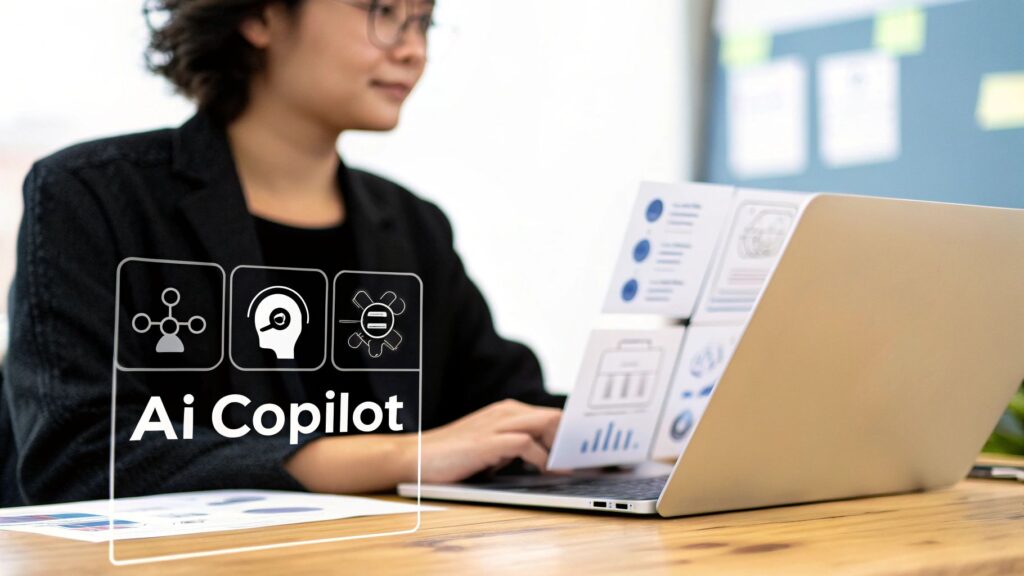The way we hire is changing, and fast. It’s a mix of smart technology, a fresh focus on what people can actually do rather than just their credentials, and the new reality of flexible work. We’re moving away from gut-feel decisions and towards a more data-driven, agile, and inclusive way of finding the right people.
Charting the New Course in Talent Acquisition

The old playbook for attracting and keeping top talent is officially obsolete. Relying on prestigious degrees, forcing everyone into a rigid office structure, and drowning in manual paperwork just doesn’t cut it anymore. In fact, it’s quickly becoming a major disadvantage.
What we’re seeing now is a complete rewrite, driven by powerful technology and what today’s candidates truly expect from an employer. This isn’t just about adopting the latest trends; it’s about a fundamental shift in how we think about building a workforce. To stay competitive, organisations have to embrace a whole new set of rules.
This table gives a quick snapshot of the foundational changes we’re seeing.
Key Shifts Shaping the Future of Hiring
| Traditional Approach | Future-Forward Approach |
|---|---|
| Relying on pedigree and CVs | Prioritising verifiable skills and potential |
| Manual, repetitive screening | AI-powered sourcing and automation |
| Gut-feel, inconsistent interviews | Data-driven, structured decision-making |
| Rigid, on-site work models | Flexible, hybrid, and remote options |
| Reactive “post and pray” recruitment | Proactive talent pipelining and branding |
| Siloed, transactional function | Integrated, strategic talent acquisition engine |
These shifts aren’t just cosmetic; they represent a deeper understanding of how to build a resilient, high-performing team for the long haul.
Key Drivers of Change
This evolution isn’t happening by chance. A few interconnected forces are completely reshaping the world of work:
- AI and Automation: Technology is no longer a simple tool; it’s a strategic partner. AI platforms can sift through thousands of applications and handle the repetitive grunt work, freeing up recruiters to do what they do best: build relationships and think strategically.
- The Skills-First Mindset: Forward-thinking companies are now asking, “What can this person do?” instead of “Where did they go to university?”. This focus on practical capabilities blows the doors open to wider, more diverse talent pools and ensures the business has the right skills to meet its goals.
- Flexible Work Models: The genie is out of the bottle. The demand for remote and hybrid work has permanently changed the game, forcing companies to get creative with how they foster collaboration, build culture, and structure compensation.
This strategic pivot is crucial for growth, especially in a dynamic market like India. The hiring landscape is heating up, with a significant 19% rise in overall hiring intent compared to last year. Sectors like manufacturing and automotive are showing incredible confidence with intent at 25% and 20% respectively. This boom highlights just how urgently modern recruitment strategies are needed. You can dig deeper into these numbers in the India Decoding Jobs Report.
The core challenge for every organisation is to move from a reactive recruitment function to a proactive talent acquisition engine. This means anticipating future needs, building talent pipelines, and creating an experience that attracts the best people, regardless of where they are.
Ultimately, the future of hiring is about building a smarter, fairer, and more effective bridge between great talent and great opportunities. It requires a real commitment to learning and adapting. The organisations that get this right won’t just win the war for talent—they’ll be set up for success for years to come.
How AI Is Your New Recruitment Copilot

Let’s clear the air about Artificial Intelligence in the future of hiring. Forget the sci-fi takeover scenarios. Think of AI as a highly skilled copilot, sitting right alongside your recruitment team. Its real job is to take on the repetitive, data-heavy lifting that drains your team’s time and energy.
Imagine an assistant that can sift through thousands of résumés in minutes, coordinate interviews across clashing time zones, and analyse market data to suggest competitive salary bands. That’s the kind of power AI brings to the table. By automating these grunt-work processes, it frees up your recruiters to do what they do best.
This means they can spend more time building real relationships with candidates, digging into cultural fit, and making the kind of nuanced judgements that technology just can’t handle.
Augmenting Human Capabilities, Not Replacing Them
There’s a lot of chatter about AI making recruiters obsolete. The reality is far more interesting—it’s about collaboration. AI is here to augment human intelligence, not replace it. It crunches the numbers so your people can focus on the human side of hiring. You can get a deeper perspective by exploring the real impact of AI on job security.
For instance, an AI tool can scan your applicant tracking system (ATS) for candidates with niche technical skills. But only a human recruiter can gauge a candidate’s drive, curiosity, and how well they’ll click with the team during a real conversation.
This partnership makes the whole hiring process faster, fairer, and a lot more effective. It’s a shift from administrative overload to strategic talent engagement.
Practical Applications of AI in Recruitment
AI in recruitment isn’t just a futuristic concept; it’s being used right now to get ahead. Here are a few ways it’s already making a difference:
- Writing Unbiased Job Descriptions: AI tools can scan your job postings for language that might subtly put off certain candidates, helping you write more inclusive ads that attract a wider pool of talent.
- Identifying Passive Candidates: Smart algorithms can search professional networks and public data to find brilliant people who aren’t even looking for a job but are a perfect match for your open roles.
- Automated Candidate Screening: AI can rapidly filter countless applications, ranking them based on your specific criteria like skills and experience. This ensures a top-tier applicant never gets lost in the shuffle.
The true value of AI in recruitment lies in its ability to process vast amounts of data without fatigue or bias, presenting human decision-makers with a curated, high-quality pool of talent to engage with.
This data-driven approach is no longer a “nice-to-have.” In India, key sectors like IT, retail, and telecom are bracing for huge growth, which only heats up the competition for skilled professionals. Companies are ditching gut-feel hiring for data-backed strategies, using AI to find and attract the right people far more efficiently.
The Impact on Candidate Experience
It’s not just about internal efficiency. AI has a massive impact on the candidate’s journey, too. We all know a slow, clunky hiring process is a huge turn-off for top talent.
AI-powered chatbots can give candidates instant answers to their questions, 24/7, keeping them in the loop and feeling valued. Automated scheduling tools can finally put an end to the frustrating email tennis of finding a good interview time.
Ultimately, by treating AI as a copilot, you’re not just making your internal processes smoother. You’re building a modern, responsive, and respectful recruitment engine that wins over the best talent in a cut-throat market. The future of hiring is a powerful blend of human insight and machine intelligence, and it’s already here.
Making the Shift to Skills-Based Hiring
The old way of figuring out a candidate’s potential just isn’t cutting it anymore. For decades, hiring managers have leaned on credentials like university degrees and fancy job titles as shorthand for competence. But that’s like judging a chef by the reputation of their culinary school instead of actually tasting their food—it completely misses the most important ingredient: genuine skill.
The future of hiring is pivoting from where a candidate has been to what they can actually do. This is the heart of skills-based hiring, a model that puts a person’s proven abilities, competencies, and potential front and centre, over their formal background.
Think of it like building a championship sports team. A savvy manager doesn’t just sign players from famous clubs; they scout for specific talents—pinpoint accuracy, strategic thinking, raw speed. They build a roster based on skills that complement each other, not just the logos on past jerseys. This is precisely how the most forward-thinking organisations are building their teams today.
Why Skills Outweigh Credentials
The traditional, degree-first approach automatically screens out a huge pool of incredible talent. It dismisses self-taught experts, seasoned professionals who forged non-traditional career paths, and brilliant individuals who honed their skills through apprenticeships or online courses. This doesn’t just shrink your talent pool; it stifles diversity and innovation.
A skills-first mindset flips that script entirely. It recognises that valuable expertise can be picked up anywhere, not just inside the lecture halls of a university. The data consistently shows that focusing on skills over degrees builds a more diverse, capable, and agile workforce.
By focusing on what candidates can demonstrably do, organisations unlock access to talent they would have otherwise overlooked. This move is not just about fairness; it is a strategic imperative for building a resilient workforce ready for any challenge.
This approach also tackles the widening gap between what’s taught in academia and what’s actually needed on the job. The debate over whether skills or a degree are more crucial to landing a job is a major one, and more and more organisations are siding with practical ability. You can dive deeper into this dynamic in our detailed analysis of the ongoing skills vs. degree debate.
Putting Skills-Based Hiring Into Practice
Making the move to a skills-first model takes more than a simple change in outlook; it demands real, practical adjustments to how you recruit. The aim is to create multiple touchpoints where candidates can truly show you what they’re made of.
Here are a few concrete steps to get you started:
- Deconstruct Your Job Roles: Start by breaking down each role into its essential competencies. Instead of listing “Bachelor’s degree in Marketing,” get specific about the skills needed, like “proven experience running multi-channel digital campaigns” or the “ability to analyse campaign data and generate performance reports.”
- Rewrite Job Descriptions: Your job descriptions are your first handshake with potential hires. Overhaul them to be skills-focused. Ditch unnecessary degree requirements and use language that speaks directly to the tasks and challenges they’ll face in the role.
- Integrate Practical Assessments: This is where the theory hits the road. Use tools and methods that let candidates demonstrate their skills in a tangible, meaningful way.
Methods for Assessing Skills
Bringing assessments into your process is critical for validating a candidate’s capabilities. The trick is to pick a method that accurately mirrors the day-to-day demands of the job itself.
- Work Sample Tests: Ask a software developer to debug a snippet of code, a content writer to draft a short blog post, or a financial analyst to build a simple forecast model. These mini-projects give you direct proof of their skills.
- Situational Judgement Tests (SJTs): Present candidates with realistic workplace scenarios and ask how they’d handle them. This is a fantastic way to evaluate soft skills like problem-solving, communication, and collaboration.
- Competency-Based Interviews: Frame your interview questions around specific skills. Instead of the generic, “Tell me about your last job,” try asking, “Describe a time you had to manage a tight deadline. What steps did you take, and what was the outcome?” This prompts candidates to provide concrete evidence of their abilities.
By making this fundamental shift, you’re doing more than just modernising your hiring process. You are building a more equitable system that finds and hires the absolute best person for the job, no matter their background. This is the practical, powerful core of the future of hiring.
Building a Flexible and Diverse Workforce
The old picture of a workforce—everyone commuting to the same office, day in and day out—is quickly becoming a relic. The future of hiring isn’t about filling seats anymore. It’s about building a dynamic, skilled, and diverse team, no matter where they log in from. This new approach weaves together three powerful trends: remote work, the gig economy, and a real commitment to Diversity, Equity, and Inclusion (DE&I).
These aren’t siloed initiatives to be handed off to different departments. Think of them as interconnected threads in a single, powerful strategy. When you braid them together, you create a workforce that’s more resilient, more innovative, and a true reflection of the global market you serve. Getting this right gives your organisation a serious competitive edge.
Remote Work as a Catalyst for Diversity
One of the most powerful outcomes of embracing remote and hybrid work is how it naturally fuels diversity. When you remove the chains of geography, your talent pool instantly explodes from a single commutable area to the entire country—or even the world.
This simple shift dismantles old barriers that have kept talented people out. It opens doors for skilled professionals in smaller towns, working parents who need flexibility, and people with disabilities who might find a traditional office setup difficult. The result? A richer tapestry of backgrounds, experiences, and perspectives that drive genuine innovation and better business outcomes. For a closer look, explore our guide on embracing diversity in your hiring practices.
This conceptual map shows how the focus is shifting away from rigid credentials toward a more modern, fluid understanding of talent.

As you can see, the progression is clear: moving from an outdated reliance on credentials to a focus on skills, which is the key to connecting with the right people.
Tapping into the Gig Economy for On-Demand Skills
Beyond your permanent remote team, the gig economy offers another powerful layer of flexibility and specialised talent. It’s like having an entire roster of expert consultants on speed dial, ready to bring their niche skills to specific projects without the long-term overhead of a full-time hire.
This on-demand model gives companies incredible agility. Need a data scientist for a three-month project? A UX designer to overhaul your app? The gig economy connects you with top-tier professionals for exactly how long you need them.
This isn’t just about controlling costs; it’s about injecting fresh, specialised knowledge into your teams exactly when you need it. You can tackle new challenges and seize opportunities fast, without getting bogged down in traditional hiring cycles for every single need.
By blending a core team of full-time employees with a flexible network of gig workers, companies can build a ‘liquid workforce’—one that can expand, contract, and reconfigure its skills in real-time to meet market demands.
This trend is surging in India. The job market is undergoing a huge transformation, with white-collar hiring jumping by 38% year-on-year. Even more telling is the rapid expansion of the gig economy, which saw a 17% year-on-year increase in hiring. A massive 66% of these gigs are now driven by corporate needs, not just individual consumers, as detailed in the latest foundit Insights Tracker report.
Comparing Modern Workforce Models
To build a cohesive strategy, it helps to understand how these different models function and what unique advantages they bring to the table.
| Model | Key Characteristics | Primary Benefits |
|---|---|---|
| Remote/Hybrid | Employees work partially or fully outside a central office. Focus is on output, not location. | Access to a global talent pool, increased employee satisfaction, and improved diversity. |
| Gig Economy | Independent contractors are hired for specific projects or tasks with defined outcomes. | Ultimate flexibility, access to specialised niche skills, and cost-effective for short-term needs. |
| Inclusive (DE&I) | A foundational culture that ensures fairness, equity, and a sense of belonging for all workers. | Drives innovation, enhances problem-solving, improves company reputation, and boosts retention. |
Each model offers distinct benefits, but their true power is unleashed when they work in concert.
Creating a Unified Workforce Strategy
The magic happens when you combine these elements into a single, cohesive plan. Remote work expands your talent pool, DE&I ensures that pool is rich and inclusive, and the gig economy gives you the agility to fill skill gaps on demand.
Successfully leading this blended workforce, however, requires a new playbook. It calls for crystal-clear communication, robust digital tools, and a culture that measures results, not facetime. Leaders must be intentional about creating a unified culture that embraces everyone—from full-time remote employees to temporary gig workers—making sure each person feels valued and connected to the company’s mission.
By mastering this integrated approach, you aren’t just getting ready for the future of hiring—you are actively building it.
Rethinking Your Hiring Strategy and Metrics
As the world of work changes, the old rulebook for talent acquisition is quickly becoming irrelevant. If your recruitment team is still laser-focused on metrics like time-to-fill, you’re trying to navigate a brand-new landscape with an old, tattered map. The future of hiring isn’t about speed; it’s about impact. It’s about connecting every recruitment action directly to real, tangible business outcomes.
This means we have to start asking bigger, better questions. Are we actually hiring the right people? Is our workforce getting more diverse, more innovative? Are our new joiners hitting the ground running and, crucially, are they sticking around? These are the questions that push us to evolve our Key Performance Indicators (KPIs).
For Chief Human Resources Officers (CHROs) and other hiring leaders, this isn’t just a minor tweak—it’s a fundamental pivot. It’s about shifting the perception of recruitment from a transactional cost centre to a strategic powerhouse that drives long-term value for the entire organisation.
Auditing Your Current Hiring Process
You can’t build a better future without first understanding your present. Kicking things off with a thorough audit of your current hiring process is non-negotiable. This isn’t just about staring at spreadsheets; it’s about getting into the weeds and finding the real-world friction points that are slowing you down and costing you great candidates.
Start by mapping out every single step of your recruitment journey, from the moment a manager raises a job requisition to a new hire’s crucial first 90 days. As you walk this path, be relentless in asking the tough questions.
- Where are candidates dropping off? If you’re seeing a mass exodus after the initial application, it’s a massive red flag that your process is probably too clunky or frustrating.
- How long is each stage really taking? Those long, silent gaps between interviews? That’s prime time for your top candidates to accept an offer from a more nimble competitor.
- Is interviewer feedback consistent? Without a structured feedback loop, you’re opening the door to biased, inconsistent, and ultimately poor hiring decisions.
Uncovering these pain points gives you a crystal-clear roadmap for what needs to change. It shows you exactly where outdated habits are costing you not just time and money, but access to the very best talent out there.
Adopting Future-Ready Hiring Metrics
Once you’ve identified the bottlenecks, it’s time to align your metrics with what truly drives the business forward. This means ditching the old vanity metrics and embracing KPIs that actually tell a story about quality, performance, and strategic impact.
The real goal here is to stop measuring the speed of your hiring and start measuring the impact of your hires. This is the shift that separates a reactive, order-taking recruitment function from a proactive, strategic talent acquisition engine.
So, what should be on every modern CHRO’s dashboard? It’s about moving from traditional ideas to a more forward-thinking approach.
| Traditional Metric (Efficiency-Focused) | Modern Metric (Impact-Focused) |
|---|---|
| Time-to-Fill | Quality of Hire |
| Cost-per-Hire | New Hire Performance |
| Number of Applicants | Diversity & Inclusion Improvements |
| Source of Hire | Skill Gap Analysis |
Let’s unpack why this is such a game-changer. Take Quality of Hire. This isn’t just one number; it’s a powerful blend of data points like a new hire’s performance review scores, their retention rate after a year, and direct feedback from their manager. It paints a far richer picture of success than just knowing how many days a role was open.
Likewise, tracking Diversity and Inclusion Improvements proves whether your hiring efforts are actually building a more innovative and representative team. Analysing Skill Gaps allows you to look around the corner and see what competencies your organisation will need tomorrow, letting you hire with foresight instead of just filling today’s empty seats.
Partnering for a Successful Transformation
Let’s be honest: overhauling your entire hiring strategy and measurement framework is a massive undertaking. It demands new technology, serious analytical muscle, and a significant cultural shift across the business. This is exactly where bringing in an expert partner can be the difference between success and failure.
A Recruitment Process Outsourcing (RPO) provider like Talent Hired does more than just fill roles. We bring the technology, the data analytics, and the strategic expertise needed to guide your evolution. We can help you run a comprehensive audit, implement the right measurement tools, and work with your teams to foster a truly data-driven mindset.
By leaning on experts, you can navigate this change with confidence, ensuring your hiring strategy isn’t just keeping up with the future of work—it’s actively shaping your organisation’s success within it.
Navigating the complexities of modern talent acquisition requires a strategic partner. Taggd specialises in Recruitment Process Outsourcing, helping you build a future-ready hiring engine with the right technology, data, and expertise. Discover how we can support your transformation at Taggd.






